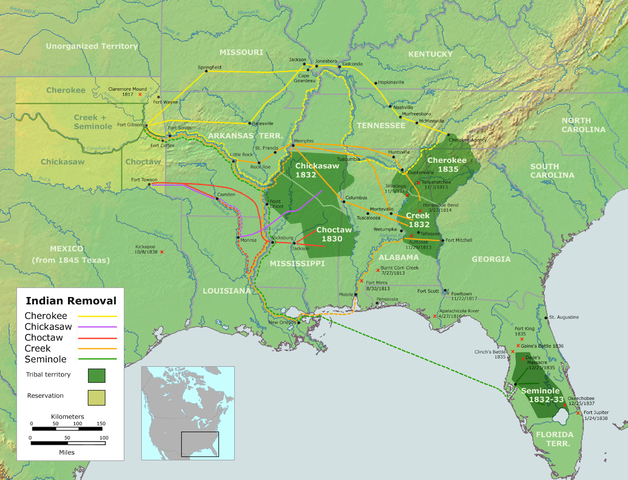
The trail of tears was one of the many consequences of failed Indian policy in the 19th century.
Small libraries could
be filled with the volumes of scholarly works that have been
written and published over the past two centuries on the evolution
of federal Indian policy. Much of that work is
fine-grained investigations of settled principles of federal Indian
law, case law, and legal theory. (click here for more)
Here are a few of the policies that guide most decisions
at the federal level:
Federal Power and Obligations
- The Commerce Clause of the U.S. Constitution, treaty
rights, and the Indian Non-Intercourse Acts, preempt the exercise
of state power over Indian lands and resources. This is
source of constant friction between the states and tribes.
- Exclusive power over Indian matters flows to Congress
from the Indian Commerce Clause of the Constitution. Congress
has the exclusive right to regulate commerce with the tribes.
- The 1790 Trade and Intercourse Act formalized the role of the
federal government as a necessary participant in Indian land
transactions. It underlies viable Indian land claims in the
21st century.
- Congress has plenary power (Hitchcock v. Lone Wolf)over the
tribes, but that absolute power is balanced by absolute
responsibility and fiduciary obligations as a guarantor for the
tribes' land and resources (i.e., timber, minerals, oil,
water).
- Congress can abrogate treaties, alter tribal powers, and
extinguish title to land (but not to tribal owned 'commons' held in
trust).
- The U.S. Supreme Court has said it will review legislative
actions to make sure they are rationally tied to the fulfillment of
Congress' unique obligation toward Indians - obligations it has
ignored, from time to time, with tragic consequences.
- Courts have insisted that the Executive department conduct its
dealings with Indians by the highest fiduciary standards.
Where public duty is in conflict with the interests of the Indians,
public duty should yield.
- The federal courts have jurisdiction over Indians on the
rez in certain federal cases.
- States have little or no authority over Indian people, their
land, or their resources.
- Indian legal rights are the oldest in our society.
Native rights were recognized in order to provide a
means for the occupation and sovereignty of the United States to be
extended across the continent with a minimum of human costs.
History reminds
us that principles are one thing, and actions are often something
entirely different. No one has been more eloquent in
describing federal Indian policy than the 19th century native
rights activist, Wendell Phillips, who said: "...the system of
injustice, oppression, and robbery which the Government calls 'its
Indian Policy," which has covered it with disgrace as incompetent,
cruel, faithless, never keeping its treaties, and systematically
and shamelessly violating its most solemn promises, has earned the
contempt and detestation of all honest men and the distrust and
hate of the Indian tribes."
Related Events
Related Flashpoints
Related Places